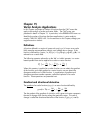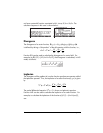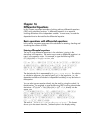
Page 15-1
Chapter 15
Vector Analysis Applications
In this Chapter we present a number of functions from the CALC menu that
apply to the analysis of scalar and vector fields. The CALC menu was
presented in detail in Chapter 13. In particular, in the DERIV&INTEG menu we
identified a number of functions that have applications in vector analysis,
namely, CURL, DIV, HESS, LAPL. For the exercises in this Chapter, change your
angle measure to radians.
Definitions
A function defined in a region of space such as φ(x,y,z) is known as a scalar
field, examples are temperature, density, and voltage near a charge. If the
function is defined by a vector, i.e., F(x,y,z) = f(x,y,z)i+g(x,y,z)j+h(x,y,z)k, it is
referred to as a vector field.
The following operator, referred to as the ‘del’ or ‘nabla’ operator, is a vector-
based operator that can be applied to a scalar or vector function:
When this operator is applied to a scalar function we can obtain the gradient
of the function, and when applied to a vector function we can obtain the
divergence and the curl of that function. A combination of gradient and
divergence produces another operator, called the Laplacian of a scalar
function. These operations are presented next.
Gradient and directional derivative
The gradient of a scalar function φ(x,y,z) is a vector function defined by
The dot product of the gradient of a function with a given unit vector represents
the rate of change of the function along that particular vector. This rate of
change is called the directional derivative of the function, D
u
φ(x,y,z) = u•∇φ.
[] [] [] []
z
k
y
j
x
i
∂
∂
⋅+
∂
∂
⋅+
∂
∂
⋅=∇
z
k
y
j
x
igrad
∂
∂
⋅+
∂
∂
⋅+
∂
∂
⋅=∇=
φφφ
φφ


















